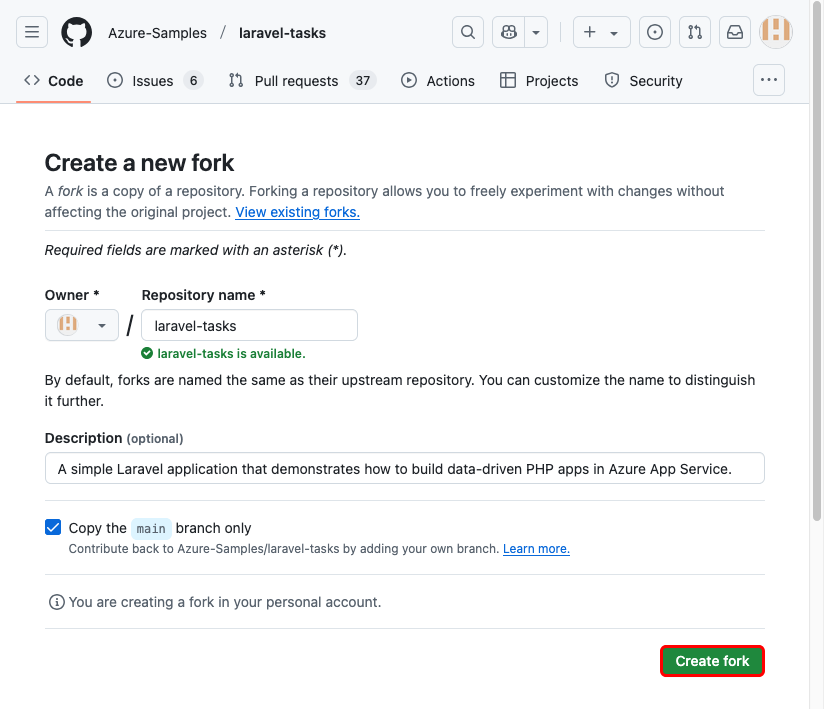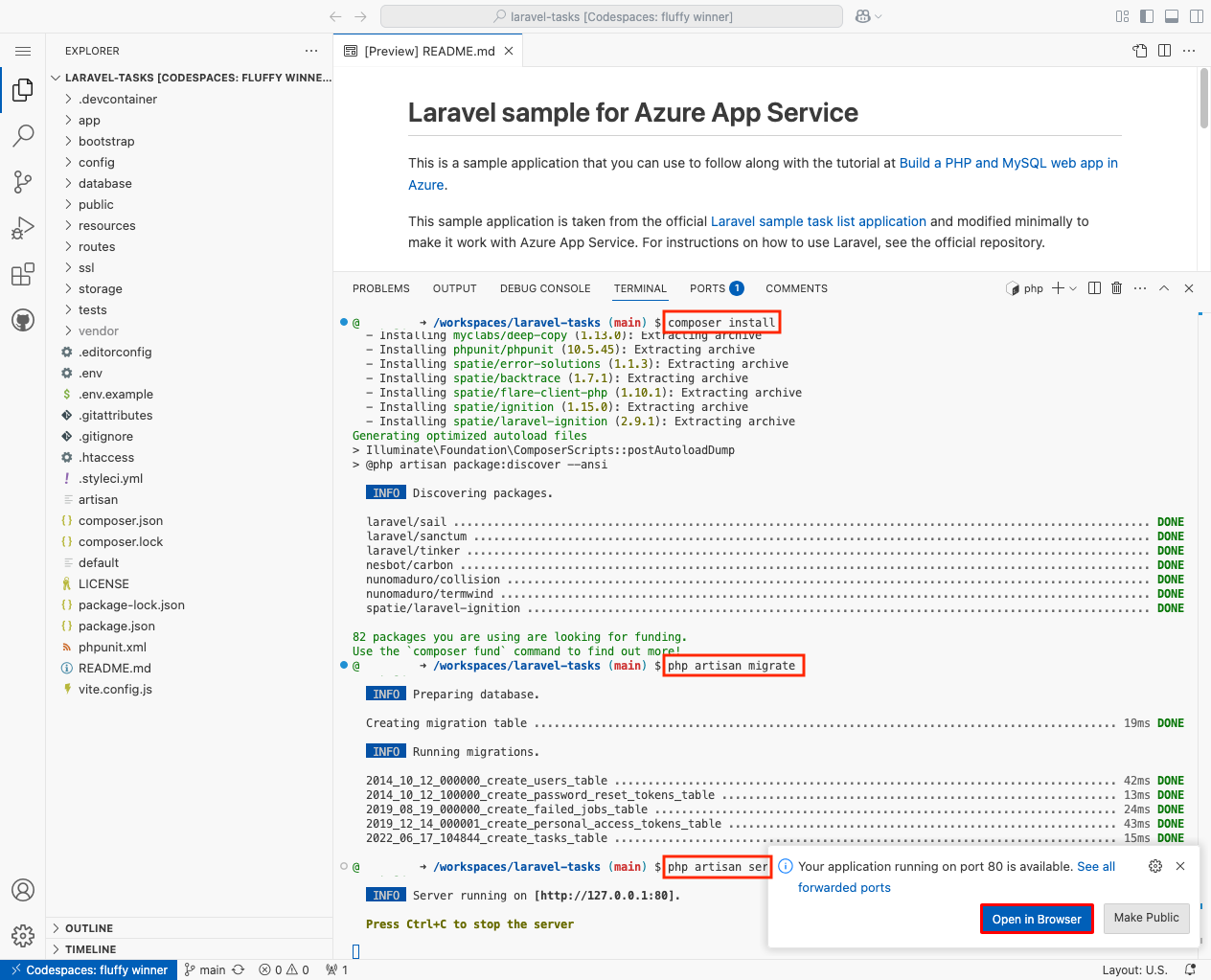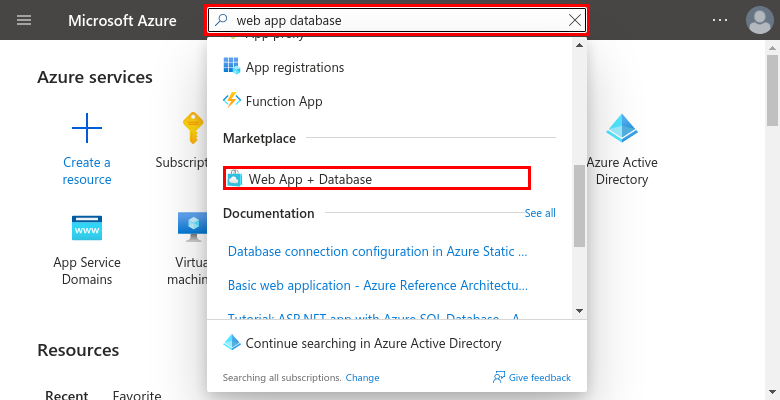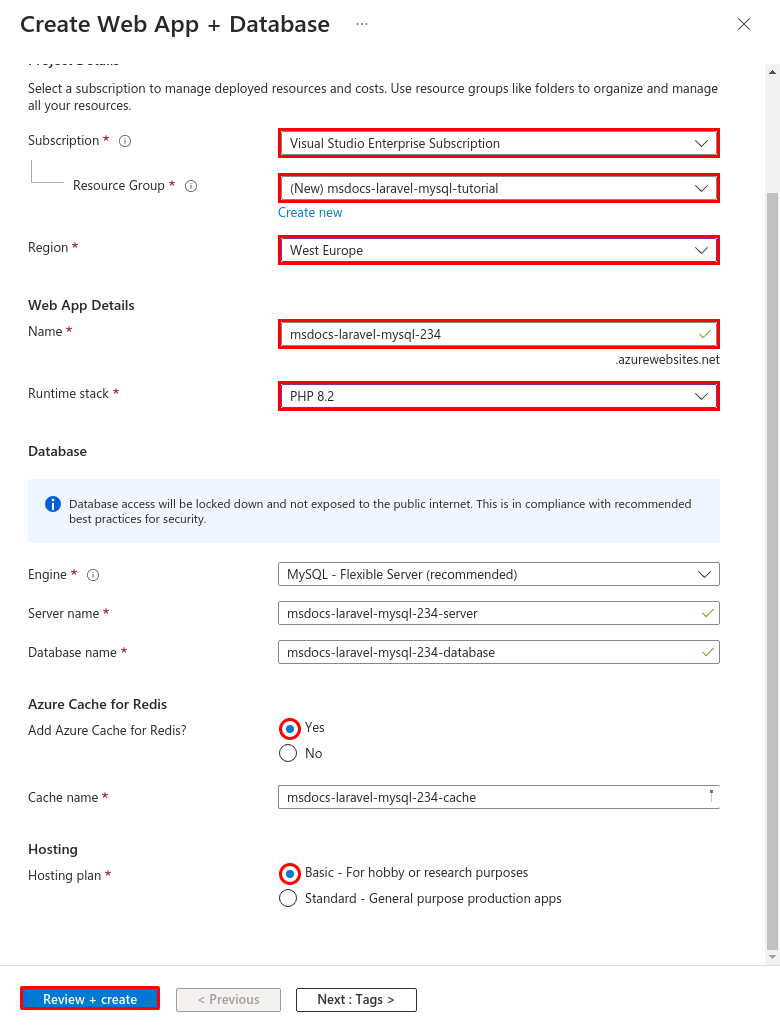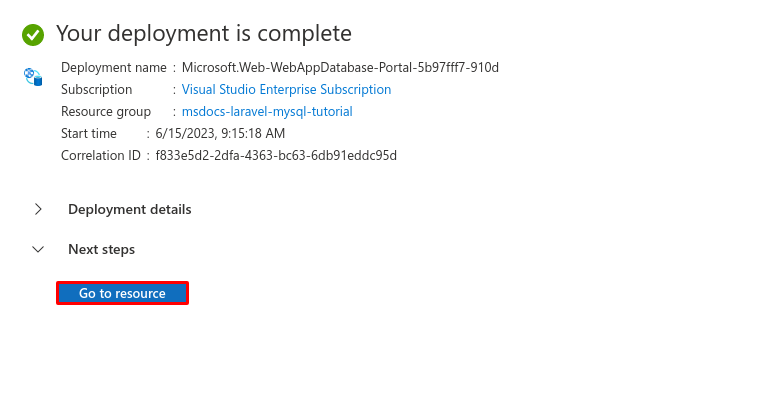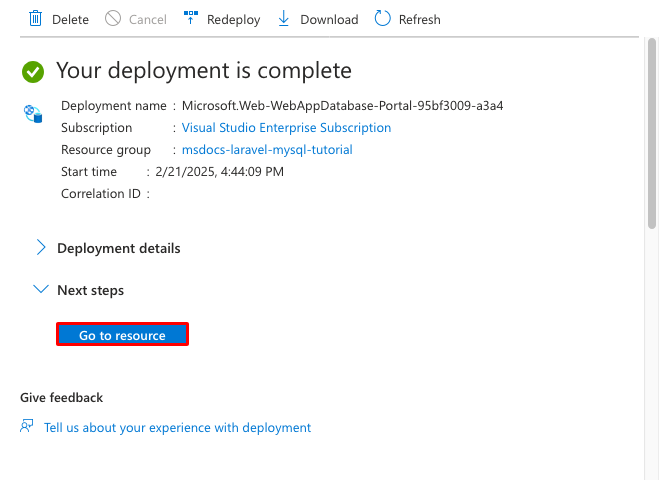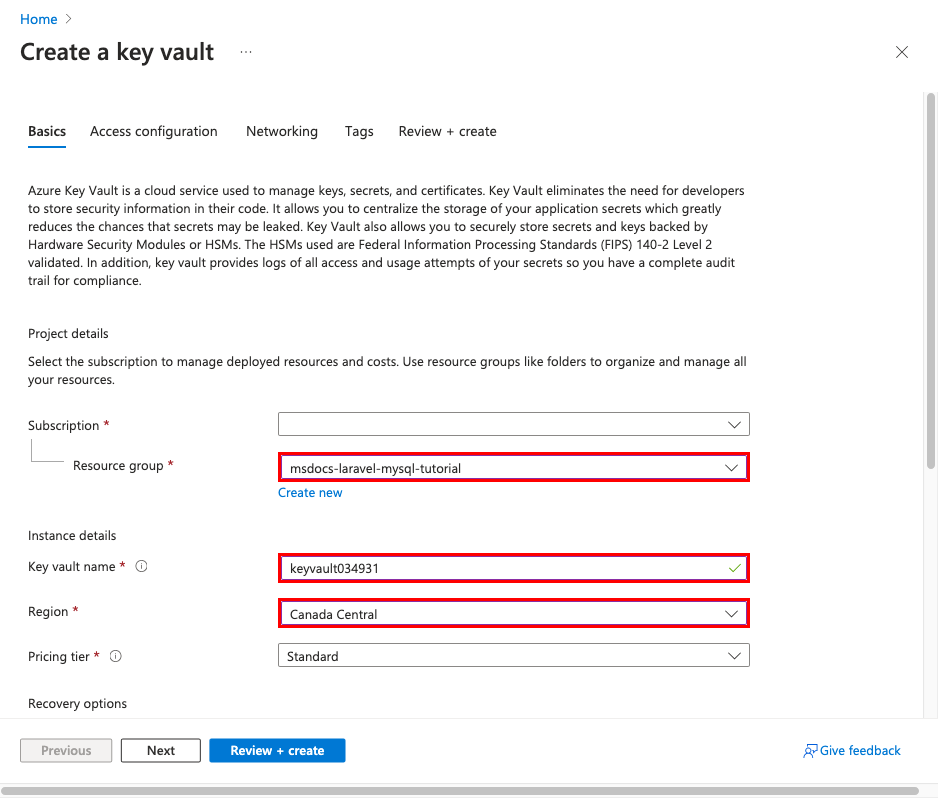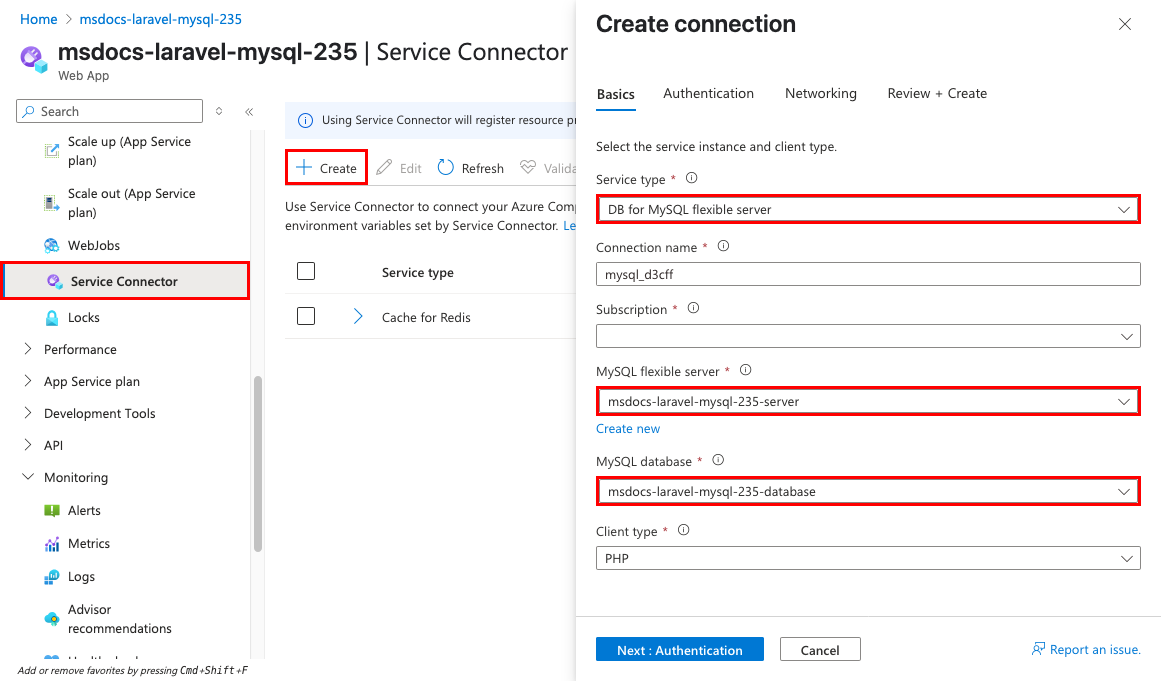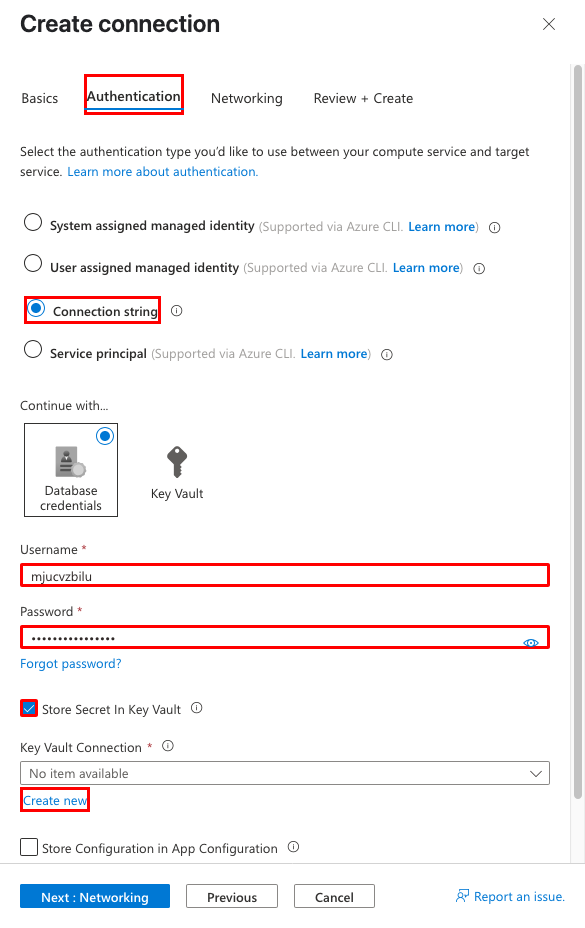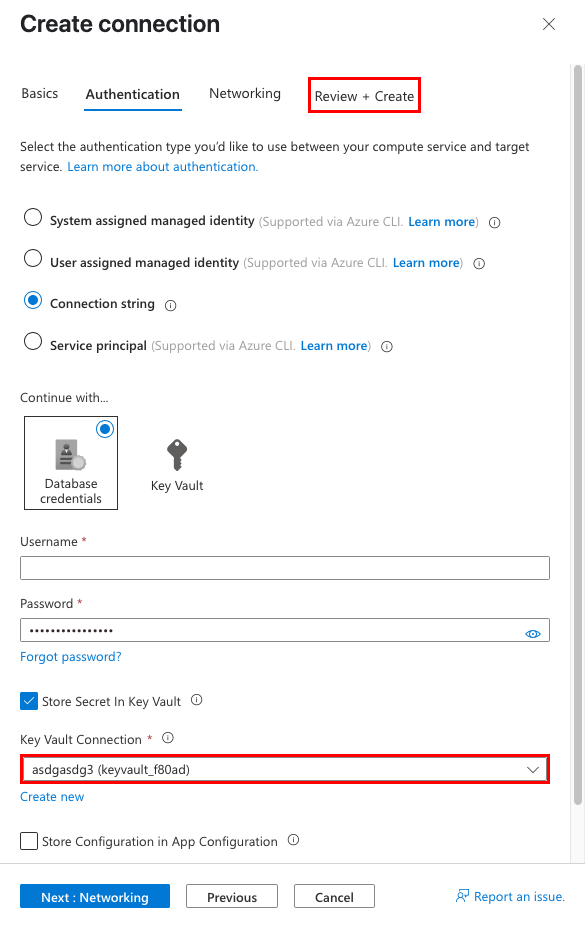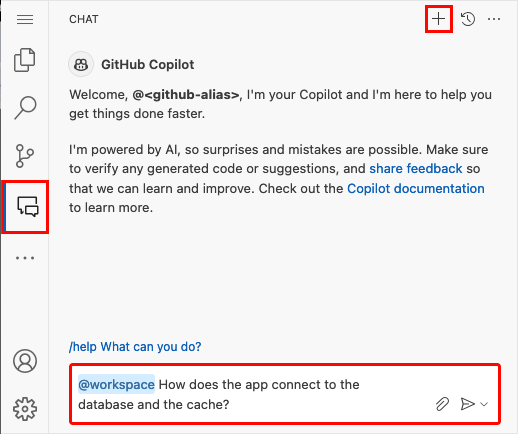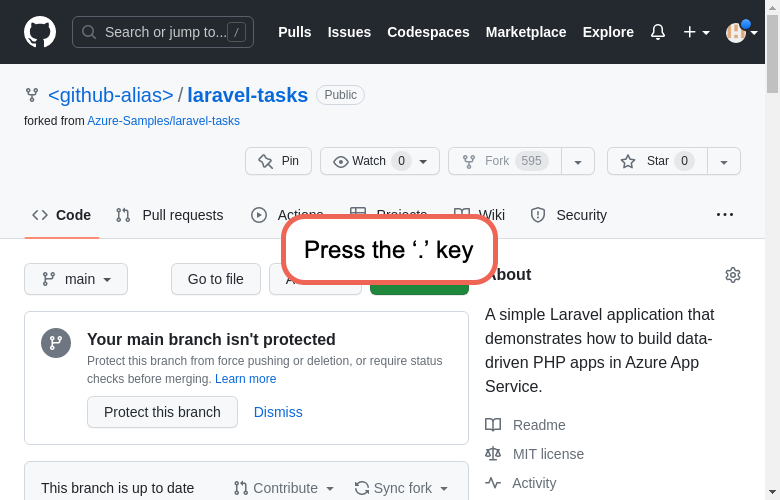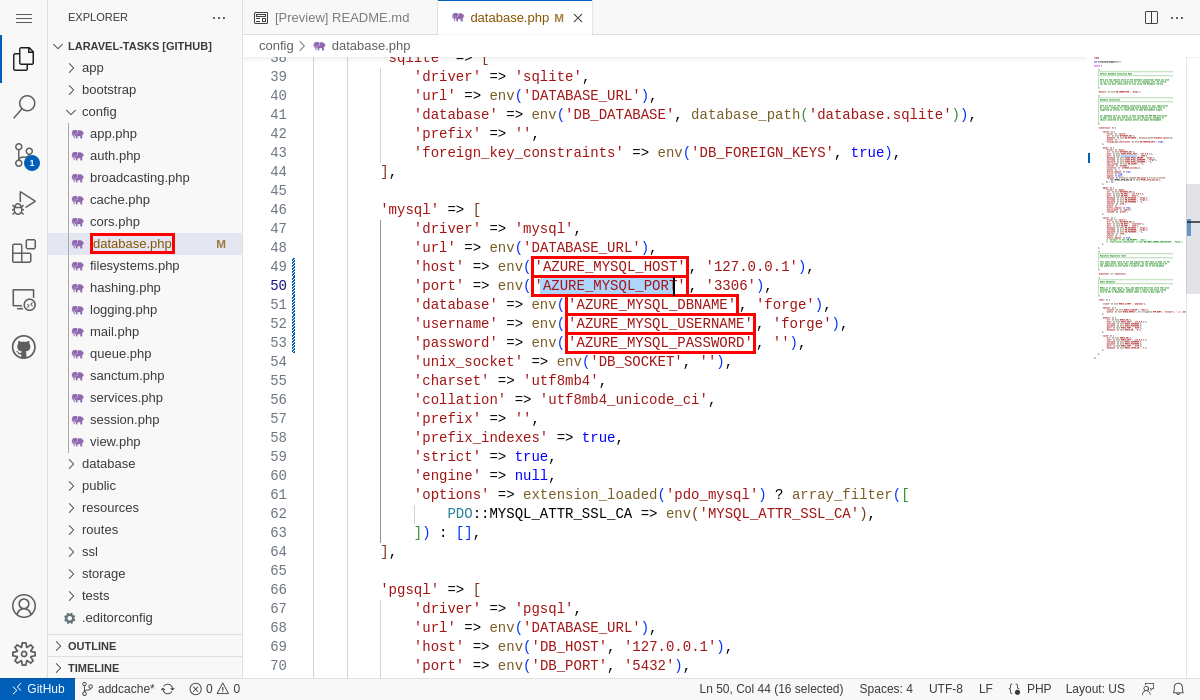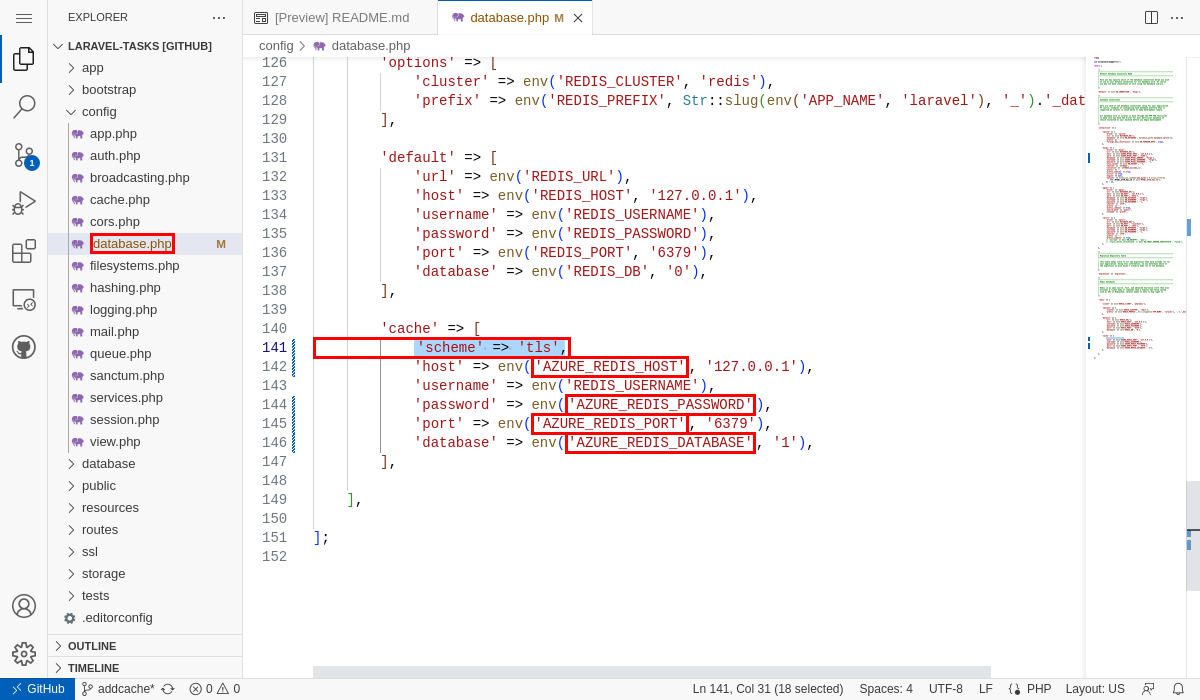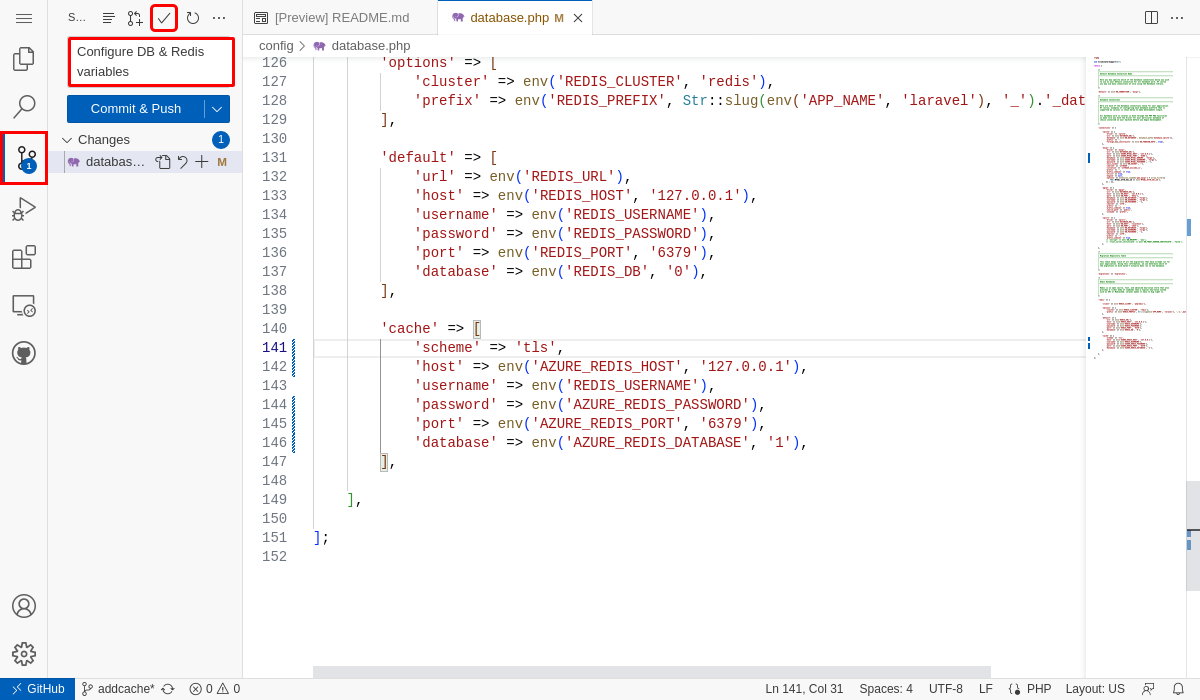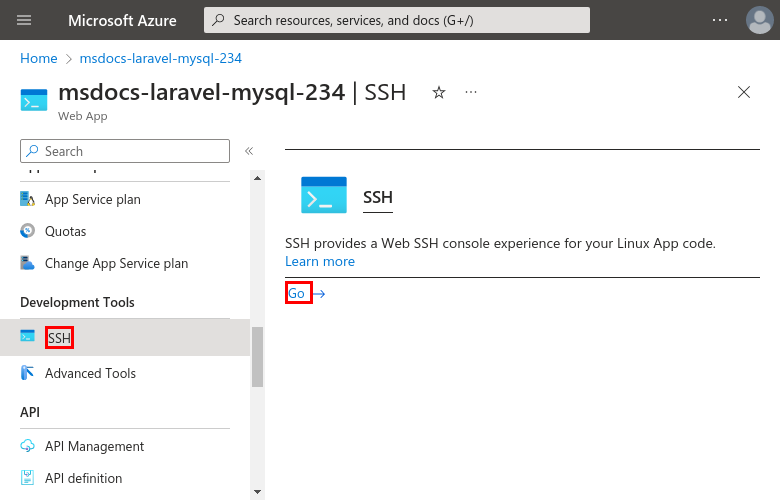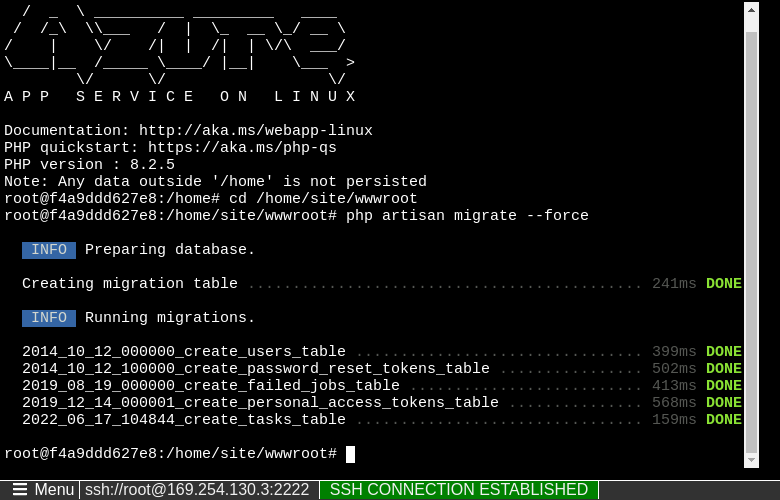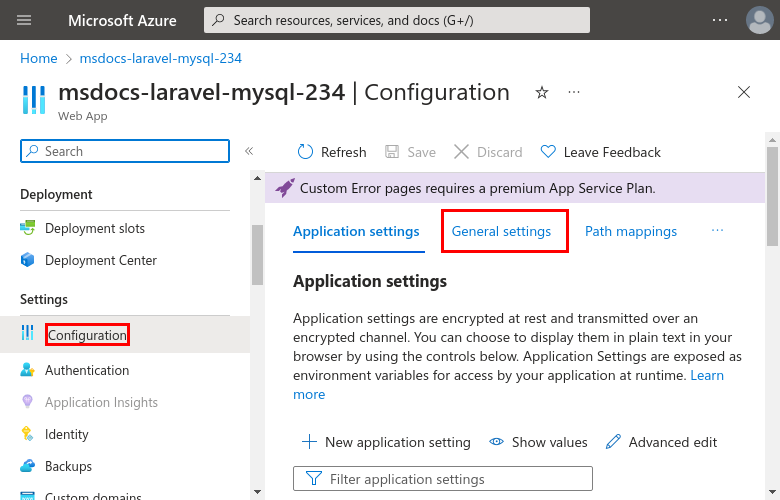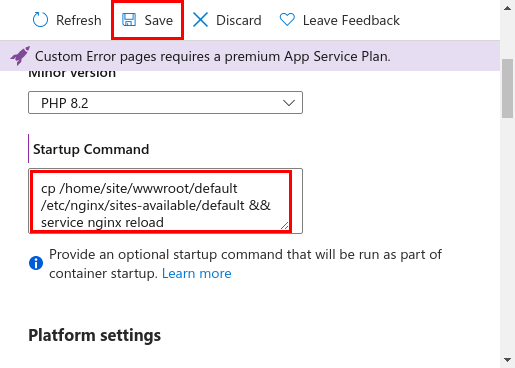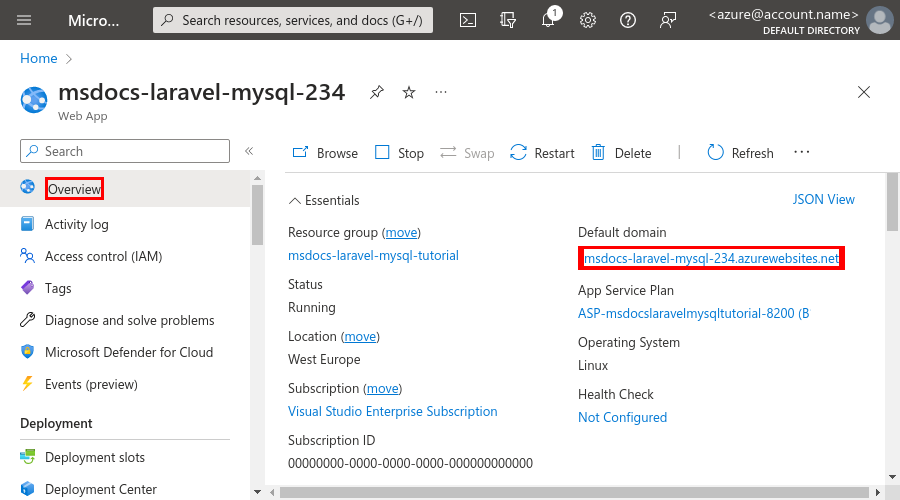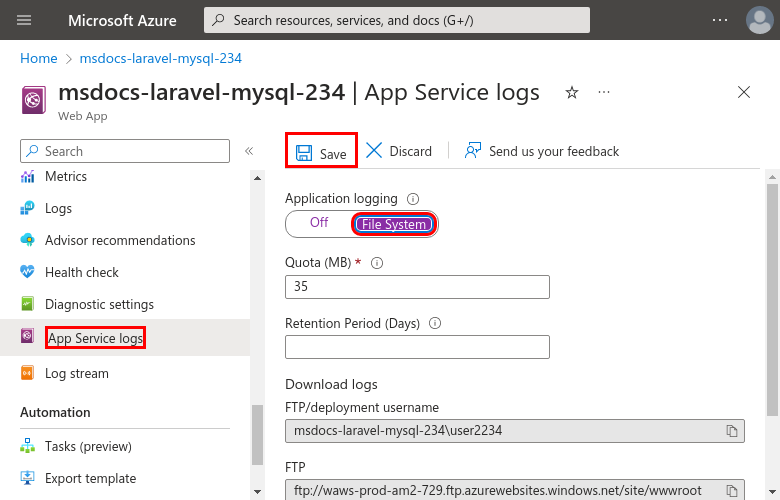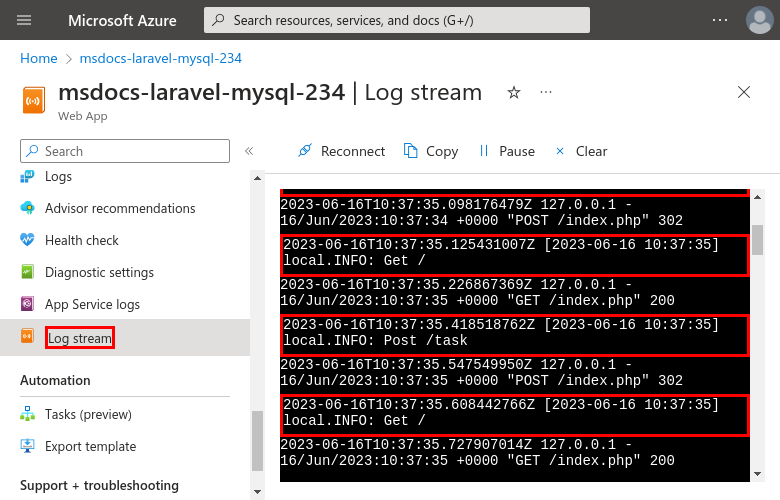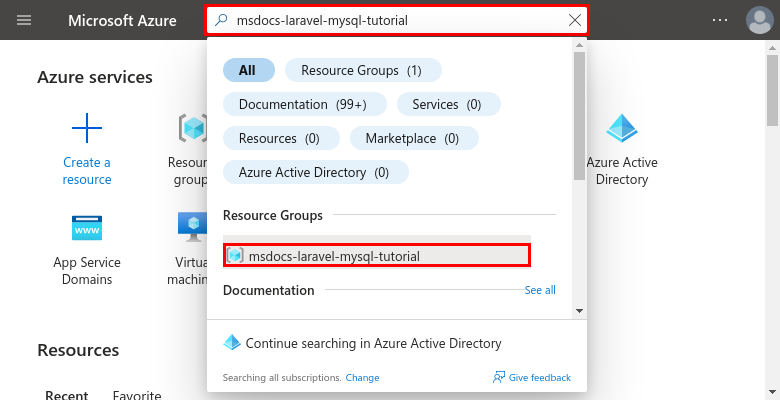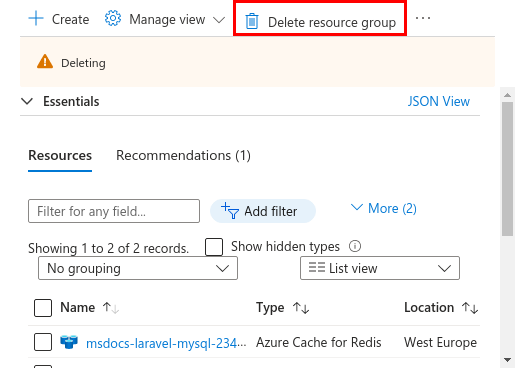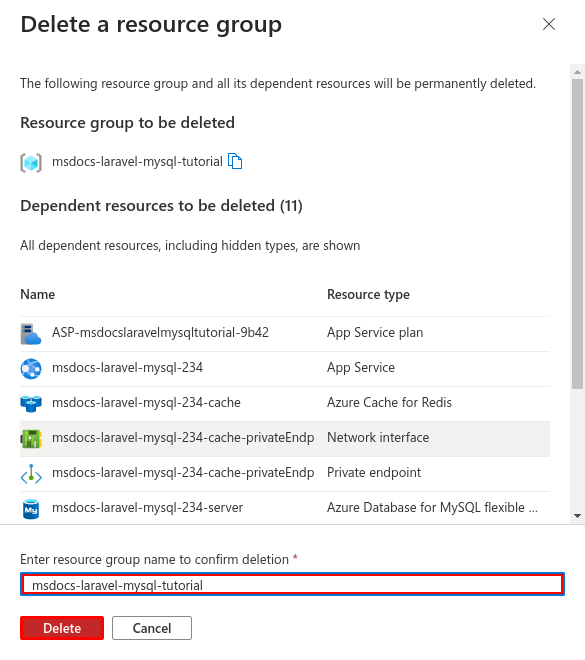Note
Access to this page requires authorization. You can try signing in or changing directories.
Access to this page requires authorization. You can try changing directories.
This tutorial shows how to create a secure PHP app in Azure App Service connects to a MySQL database using Azure Database for MySQL Flexible Server. You also deploy an Azure Cache for Redis to enable the caching code in your application. Azure App Service is a highly scalable, self-patching, web-hosting service that can easily deploy apps on Windows or Linux. When you're finished, you have a Laravel app running on Azure App Service on Linux.

Prerequisites
- An Azure account with an active subscription. If you don't have an Azure account, you can create one for free.
- A GitHub account. You can also get one for free.
- Knowledge of PHP with Laravel development.
- (Optional) To try GitHub Copilot, a GitHub Copilot account. A 30-day free trial is available.
Run the sample
Set up a sample data-driven app as a starting point. The sample repository includes a dev container configuration. The dev container has everything you need to develop an application, including the database, cache, and all environment variables needed by the sample application. The dev container can run in a GitHub codespace, which means you can run the sample on any computer with a web browser.
Step 1: In a new browser window:
- Sign in to your GitHub account.
- Navigate to https://github.com/Azure-Samples/laravel-tasks/fork.
- Select Create fork.
Step 2: In the GitHub fork:
- Select Code > Create codespace on main.
The codespace takes a few minutes to set up. Also, the provided .env file already contains a dummy
APP_KEYvariable that Laravel needs to run locally.
Step 3: In the codespace terminal:
- Run
composer install. - Run database migrations with
php artisan migrate. - Run the app with
php artisan serve. - When you see the notification
Your application running on port 80 is available., select Open in Browser. You should see the sample application in a new browser tab. To stop the application, type Ctrl + C.
Having issues? Check the Troubleshooting section.
Create App Service, database, and cache
In this step, you create the Azure resources. The steps used in this tutorial create a set of secure-by-default resources that include App Service, Azure Database for MySQL, and Azure Cache for Redis. For the creation process, you specify:
- The Name for the web app. It's used as part of the DNS name for your app.
- The Region to run the app physically in the world. It's also part of the DNS name for your app.
- The Runtime stack for the app. It's where you select the version of PHP to use for your app.
- The Hosting plan for the app. It's the pricing tier that includes the set of features and scaling capacity for your app.
- The Resource Group for the app. A resource group lets you group all the Azure resources needed for the application in a logical container.
Sign in to the Azure portal. Follow these steps to create your Azure App Service resources.
Step 1: In the Azure portal:
- In the top search bar, type app service.
- Select the item labeled App Service under the Services heading.
- Select Create > Web App. You can also navigate to Create Web App directly.
Step 2: In the Create Web App page, fill out the form as follows.
- Name: msdocs-laravel-mysql. The Azure portal creates a resource group named msdocs-laravel-mysql_group.
- Runtime stack: PHP 8.4.
- Operating system: Linux.
- Region: Any Azure region near you.
- Linux Plan: Create new and use the name msdocs-laravel-mysql.
- Pricing plan: Basic. When you're ready, you can scale up to a different pricing tier.
Step 3:
- Select Next to proceed to the Database tab.
- Select Create a Database.
- In Engine, select MySQL - Flexible Server.
- Select Create an Azure Cache for Redis.
- In Name (under Cache), enter a name for the cache.
- In SKU, select Basic.
Step 4:
- Select Next to proceed to the Deployment tab.
- Enable Continuous deployment.
- In Organization, select your GitHub alias.
- In Repository, select laravel-tasks.
- In Branch, select main.
- Make sure Basic authentication is disabled.
- Select Review + create.
- After validation completes, select Create.
Step 5: The deployment takes a few minutes to complete. To see the web app, select Go to resource. Deployment creates the following resources:
- Resource group: The container for all the created resources.
- App Service plan: Defines the compute resources for App Service. A Linux plan in the Basic tier is created.
- App Service: Represents your app and runs in the App Service plan.
- Virtual network: Integrated with the App Service app and isolates back-end network traffic.
- Private endpoints: Access endpoints for the database server and the Redis cache in the virtual network.
- Network interfaces: Represents private IP addresses, one for each of the private endpoints.
- Azure Database for MySQL Flexible Server: Accessible only from behind its private endpoint. A database and a user are created for you on the server.
- Azure Cache for Redis: Accessible only from behind its private endpoint.
- Private DNS zones: Enable DNS resolution of the database server and the Redis cache in the virtual network.
Secure connection secrets
Deployment generated the connectivity variables for you already as app settings. The security best practice is to keep secrets out of App Service completely. Move your secrets to a key vault and change your app setting to Key Vault references with the help of Service Connectors.
Step 1: Retrieve the existing connection string.
- In the left menu of the App Service page, select Settings > Environment variables.
- Select Connection strings.
- Select AZURE_MYSQL_CONNECTIONSTRING.
- In Add/Edit application setting, in the Value field, copy the username and password for use later. The connection string lets you connect to the MySQL database secured behind private endpoints. The secrets are saved directly in the App Service app, which isn't the best. You'll change this configuration.
Step 2: Create a key vault for secure management of secrets.
- In the top search bar, type "key vault", then select Marketplace > Key Vault.
- In Resource Group, select msdocs-laravel-mysql_group.
- In Key vault name, enter a name that consists of only letters and numbers.
- In Region, select the same location as the resource group.
Step 3: Secure the key vault with a Private Endpoint.
- Select the Networking tab.
- Unselect Enable public access.
- Select Create a private endpoint.
- In Resource Group, select msdocs-laravel-mysql_group.
- In the dialog, in Location, select the same location as your App Service app.
- In Name, enter msdocs-laravel-mysqlVaultEndpoint.
- In Virtual network, select the virtual network in the msdocs-laravel-mysql_group group.
- In Subnet, select the available compatible subnet.
- Select OK.
- Select Review + create, then select Create. Wait for the key vault deployment to finish. You should see Your deployment is complete.
Step 4: Create the MySQL connector.
- In the top search bar, enter msdocs-laravel-mysql, then select the App Service resource called msdocs-laravel-mysql.
- In the App Service page, in the left menu, select Settings > Service Connector.
- Select Create.
- For Service type, select DB for MySQL flexible server.
- For MySQL flexible server, select your server, for example, msdocs-laravel-mysql-server.
- For MySQL database, select your database, for example, msdocs-laravel-mysql-database.
Step 5: Configure authentication for the MySQL connector.
- Select the Authentication tab.
- Select Connection string.
- In Password, paste the password you copied earlier.
- Select Store Secret in Key Vault.
- Under Key Vault Connection, select Create new. A Create connection dialog is opened on top of the edit dialog.
Step 6: Establish the Key Vault connection.
- In the Create connection dialog for the Key Vault connection, in Key Vault, select the key vault you created earlier.
- Select Review + Create.
- When validation completes, select Create.
Step 7: Finalize the MySQL connector settings.
- You're back in the MySQL connector dialog. In the Authentication tab, wait for the key vault connector to be created. When it's finished, Key Vault Connection automatically selects it.
- Select Review + Create.
- Select Create. Wait until the Update succeeded notification appears.
Step 8: Configure the Redis connector to use Key Vault secrets.
- In the Service Connectors page, select the checkbox next to the Cache for Redis connector, then select Edit.
- Select the Authentication tab.
- Select Store Secret in Key Vault.
- Under Key Vault Connection, select the key vault you created.
- Select Next: Networking.
- Select Configure firewall rules to enable access to target service. The app creation wizard already secured the SQL database with a private endpoint.
- Select Save. Wait until the Update succeeded notification appears.
Step 9: Verify the Key Vault integration.
- From the left menu, select Settings > Environment variables again.
- Next to AZURE_MYSQL_PASSWORD, select Show value. The value should be
@Microsoft.KeyVault(...), which means that it's a key vault reference because the secret is now managed in the key vault. - To verify the Redis connection string, select Show value next to AZURE_REDIS_CONNECTIONSTRING.
To summarize, the process for securing your connection secrets involved:
- Retrieving the connection secrets from the App Service app's environment variables.
- Creating a key vault.
- Creating a Key Vault connection with the system-assigned managed identity.
- Updating the service connectors to store the secrets in the key vault.
Having issues? Check the Troubleshooting section.
Configure Laravel variables
Step 1: Create CACHE_DRIVER as an app setting.
- In your web app, select Settings > Environment variables.
- In the App settings tab, select Add.
- For Name, enter CACHE_DRIVER.
- For Value, enter redis.
- Select Apply, then Apply again, then Confirm.
Step 2: Using the same steps in Step 1, create the following app settings. After you finish, select Apply to update your App settings.
- MYSQL_ATTR_SSL_CA: Use /home/site/wwwroot/ssl/DigiCertGlobalRootCA.crt.pem as the value. This app setting points to the path of the TLS/SSL certificate you need to access the MySQL server. It's included in the sample repository.
- LOG_CHANNEL: Use stderr as the value. This setting tells Laravel to pipe logs to stderr, which makes it available to the App Service logs.
- APP_DEBUG: Use true as the value. It's a Laravel debugging variable that enables debug mode pages.
- APP_KEY: Use base64:Dsz40HWwbCqnq0oxMsjq7fItmKIeBfCBGORfspaI1Kw= as the value. It's a Laravel encryption variable.
Important
The APP_KEY value is used here for convenience. For production scenarios, it should be generated specifically for your deployment using php artisan key:generate --show in the command line.
Ideally, the APP_KEY app setting should be configured as a key vault reference too, which is a multi-step process. For more information, see How do I change the APP_KEY app setting to a Key Vault reference?
Deploy sample code
In this step, you configure GitHub deployment using GitHub Actions. It's just one of many ways to deploy to App Service, but also a great way to have continuous integration in your deployment process. By default, every git push to your GitHub repository kicks off the build and deploy action.
Step 1: Back in the GitHub codespace of your sample fork, run git pull origin main.
This command pulls the newly committed workflow file into your codespace.
Step 2 (Option 1: with GitHub Copilot):
- Start a new chat session by selecting the Chat view, then selecting +.
- Ask, "@workspace How does the app connect to the database and redis?" Copilot might give you some explanation about how the settings are configured in config/database.php.
- Ask, "@workspace In production mode, my app is running in an App Service web app, which uses Azure Service Connector to connect to a MySQL flexible server. What are the environment variable names I need to use?" Copilot might give you a code suggestion similar to the one in the Option 2: without GitHub Copilot steps and even tell you to make the change in the config/database.php file.
- Open config/database.php in the explorer and add the code suggestion.
- Ask, "@workspace My App Service app also uses Azure Service Connector to connect to a Cache for Redis using the Django client type. What are the environment variable names I need to use?" Copilot might give you a code suggestion similar to the one in the Option 2: without GitHub Copilot steps and even tell you to make the change in the config/database.php file. If prompted, sign into GitHub Copilot for Azure to get more accurate answers.
- Add the code suggestion.
GitHub Copilot doesn't give you the same response every time, and it's not always correct. You might need to ask more questions to fine-tune its response. For tips, see What can I do with GitHub Copilot in my codespace?.
Step 2 (Option 2: without GitHub Copilot):
- Open config/database.php in the explorer. Find the
mysqlsection and make the following changes: - Replace
DB_HOST(line 49) withAZURE_MYSQL_HOST. - Replace
DB_DATABASE(line 51) withAZURE_MYSQL_DBNAME. - Replace
DB_USERNAME(line 52) withAZURE_MYSQL_USERNAME. - Replace
DB_PASSWORD(line 53) withAZURE_MYSQL_PASSWORD. - Replace
DB_PORT(line 50) withAZURE_MYSQL_PORT. - Scroll to the Redis
cachesection and make the following changes: - Replace
REDIS_HOST(line 142) withAZURE_REDIS_HOST. - Replace
REDIS_PASSWORD(line 144) withAZURE_REDIS_PASSWORD. - Replace
REDIS_PORT(line 145) withAZURE_REDIS_PORT. - Replace
REDIS_CACHE_DB(line 146) withAZURE_REDIS_DATABASE. - In the same section, add a line with
'scheme' => 'tls',. This configuration tells Laravel to use encryption to connect to Redis.
Step 3:
- Select the Source Control extension.
- In the textbox, type a commit message like Configure Azure database and cache connections. Or, select
 and let GitHub Copilot generate a commit message for you.
and let GitHub Copilot generate a commit message for you. - Select Commit, then confirm with Yes.
- Select Sync changes 1, then confirm with OK.
Step 4:
- In the Azure portal, open your web app and then select Deployment > Deployment Center.
- Select Logs, then select Refresh to see the new deployment run.
- In the log item for the deployment run, select the Build/Deploy Logs entry with the latest timestamp.
Step 5: You're taken to your GitHub repository and see that the GitHub action is running. The workflow file defines two separate stages, build and deploy. Wait for the GitHub run to show a status of Success. It takes about 10 minutes.
Having issues? Check the Troubleshooting section.
Generate database schema
The creation wizard puts the MySQL database server behind a private endpoint, so it's accessible only from the virtual network. Because the App Service app is already integrated with the virtual network, the easiest way to run database migrations with your database is directly from within the App Service container.
Step 1: Back in the App Service page, in the left menu:
- Select Development Tools > SSH.
- Select Go.
Step 2: In the SSH terminal:
- Run
cd /home/site/wwwroot. Here are all your deployed files. - Run
php artisan migrate --force. If it succeeds, App Service is connecting successfully to the MySQL database.
Tip
In the SSH session, only changes to files in /home can persist beyond app restarts. Changes outside of /home aren't persisted.
Change site root
Laravel application lifecycle begins in the /public directory instead. The default PHP container for App Service uses Nginx, which starts in the application's root directory. To change the site root, you need to change the Nginx configuration file in the PHP container (/etc/nginx/sites-available/default). The sample repository contains a custom configuration file called default. As noted previously, you don't want to replace this file using the SSH shell. The change is outside of /home and is lost after an app restart.
Step 1:
- From the left menu, select Settings > Configuration.
- Select the General settings tab.
Step 2: In the General settings tab:
- In the Startup Command box, enter the following command: cp /home/site/wwwroot/default /etc/nginx/sites-available/default && service nginx reload.
- Select Save, then select Continue. The command replaces the Nginx configuration file in the PHP container and restarts Nginx. This configuration ensures that the same change is made to the container each time it starts.
Browse to the app
Step 1: In the App Service page:
- From the left menu, select Overview.
- Select the Default domain of your app.
Step 2: Add a few tasks to the list. Congratulations, you're running a secure data-driven PHP app in Azure App Service.
Tip
The sample application implements the cache-aside pattern. When you reload the page after making data changes, Response time in the webpage shows a much faster time because it's loading the data from the cache instead of the database.
Stream diagnostic logs
Azure App Service captures all messages logged to the console to assist you in diagnosing issues with your application. The sample app outputs console log messages in each of its endpoints to demonstrate this capability. By default, Laravel's logging functionality, for example, Log::info(), outputs to a local file. Your LOG_CHANNEL app setting from earlier makes log entries accessible from the App Service log stream.
Step 1: In the App Service page:
- From the left menu, select Monitoring > App Service logs.
- Under Application logging, select File System.
Step 2: From the left menu, select Log stream. You see the logs for your app, including platform logs and logs from inside the container.
Clean up resources
When you're finished, you can delete all of the resources from your Azure subscription by deleting the resource group.
Step 1: In the search bar at the top of the Azure portal:
- Enter the resource group name.
- Select the resource group.
Step 2: In the resource group page, select Delete resource group.
Step 3:
- To confirm your deletion, enter the resource group name.
- Select Delete.
Create Azure resources and deploy a sample app
In this step, you create the Azure resources and deploy a sample app to App Service on Linux. The steps used in this tutorial create a set of secure-by-default resources that include App Service and Azure Database for MySQL.
The GitHub codespace already has the Azure Developer CLI (AZD).
Generate a Laravel encryption key with
php artisan key:generate --show:php artisan key:generate --showSign into Azure by running the
azd auth logincommand and following the prompt:azd auth loginCreate the necessary Azure resources and deploy the app code with the
azd upcommand. Follow the prompt to select the desired subscription and location for the Azure resources.azd upWhen prompted, give the following answers:
Question Answer Enter a new environment name Type a unique name. The AZD template uses this name as part of the DNS name of your web app in Azure ( <app-name>-<hash>.azurewebsites.net). Alphanumeric characters and hyphens are allowed.Select an Azure Subscription to use Select your subscription. Select an Azure location to use Select a location. Enter a value for the 'appKey' infrastructure secured parameter Use the output of php artisan key:generate --showhere. The AZD template creates a Key Vault secret for it that you can use in your app.Enter a value for the 'databasePassword' infrastructure secured parameter Database password for MySQL. It must be at least 8 characters long and contain uppercase letters, lowercase letters, numbers, and special characters. The
azd upcommand takes about 15 minutes to complete. The Redis cache takes the most time. The command also compiles and deploys your application code, but you modify your code later to work with App Service. While it's running, the command provides messages about the provisioning and deployment process, including a link to the deployment in Azure. When it finishes, the command also displays a link to the deploy application.This AZD template contains files (azure.yaml and the infra directory) that generate a secure-by-default architecture with the following Azure resources:
- Resource group: The container for all the created resources.
- App Service plan: Defines the compute resources for App Service. A Linux plan in the B1 tier is created.
- App Service: Represents your app and runs in the App Service plan.
- Virtual network: Integrated with the App Service app and isolates back-end network traffic.
- Azure Database for MySQL Flexible Server: Accessible only from the virtual network through the DNS zone integration. A database is created for you on the server.
- Azure Cache for Redis: Accessible only from within the virtual network.
- Private endpoints: Access endpoints for the key vault and the Redis cache in the virtual network.
- Private DNS zones: Enable DNS resolution of the key vault, the database server, and the Redis cache in the virtual network.
- Log Analytics workspace: Acts as the target container for your app to ship its logs, where you can also query the logs.
- Key vault: Used to keep your database password the same when you redeploy with AZD.
Having issues? Check the Troubleshooting section.
Use Azure connection strings in application code
The AZD template you use generated the connectivity variables for you already as app settings and outputs them to the terminal. App settings are one way to keep connection secrets out of your code repository.
In the AZD output, find the app settings that begin with
AZURE_MYSQL_andAZURE_REDIS_. Only the setting names are displayed. They look like this in the AZD output:App Service app has the following app settings: - AZURE_KEYVAULT_RESOURCEENDPOINT - AZURE_KEYVAULT_SCOPE - AZURE_MYSQL_DBNAME - AZURE_MYSQL_FLAG - AZURE_MYSQL_HOST - AZURE_MYSQL_PASSWORD - AZURE_MYSQL_PORT - AZURE_MYSQL_USERNAME - AZURE_REDIS_DATABASE - AZURE_REDIS_HOST - AZURE_REDIS_PASSWORD - AZURE_REDIS_PORT - AZURE_REDIS_SSLSettings beginning with
AZURE_MYSQL_are connection variables for the MySQL database. Settings beginning withAZURE_REDIS_are for the Redis cache. You need to use them in your code later. The AZD template shows you the direct link to the app's app settings page in the Azure portal.From the explorer, open config/database.php. This file is the configuration file for database and Redis cache connections.
Find the part that defines the
mysqlconnection (lines 46-64) and replaceDB_HOST,DB_PORT,DB_DATABASE,DB_USERNAME, andDB_PASSWORDwith theAZURE_MYSQL_app settings from the AZD output. Yourmysqlconnection should look like the following code.'mysql' => [ 'driver' => 'mysql', 'url' => env('DATABASE_URL'), 'host' => env('AZURE_MYSQL_HOST', '127.0.0.1'), 'port' => env('AZURE_MYSQL_PORT', '3306'), 'database' => env('AZURE_MYSQL_DBNAME', 'forge'), 'username' => env('AZURE_MYSQL_USERNAME', 'forge'), 'password' => env('AZURE_MYSQL_PASSWORD', ''), 'unix_socket' => env('DB_SOCKET', ''), 'charset' => 'utf8mb4', 'collation' => 'utf8mb4_unicode_ci', 'prefix' => '', 'prefix_indexes' => true, 'strict' => true, 'engine' => null, 'options' => extension_loaded('pdo_mysql') ? array_filter([ PDO::MYSQL_ATTR_SSL_CA => env('MYSQL_ATTR_SSL_CA'), ]) : [], ],For more information on database configuration in Laravel, see Laravel documentation.
Find the part that defines the Redis cache connection (lines 140-147) and replace
REDIS_HOST,REDIS_PASSWORD,REDIS_PORT, andREDIS_CACHE_DBwith theAzure_REDIS_app settings from the AZD output. Also, add'scheme' => 'tls',to the connection. Your cache connection should look like the following code:'cache' => [ 'scheme' => 'tls', 'url' => env('REDIS_URL'), 'host' => env('AZURE_REDIS_HOST', '127.0.0.1'), 'username' => env('REDIS_USERNAME'), 'password' => env('AZURE_REDIS_PASSWORD'), 'port' => env('AZURE_REDIS_PORT', '6379'), 'database' => env('AZURE_REDIS_DATABASE', '1'), ],For more information on Redis cache configuration in Laravel, see Laravel documentation.
Note
Remember that your changes aren't deployed yet. You deploy them at the end of the next step.
Configure Laravel settings in web app
From the explorer, open infra/resources.bicep. This file is the Bicep file that defines the created Azure resources.
Find the part that defines the app settings (lines 510-514) and uncomment them. These app settings are:
Setting Description CACHE_DRIVERTells Laravel to use Redis as its cache (see Laravel documentation). MYSQL_ATTR_SSL_CANeeded to open a TLS connection to MySQL in Azure. The certificate file is included in the sample repository for convenience. This variable is used by the mysql connection in config/database.php LOG_CHANNELTells Laravel to pipe logs to stderr, which makes it available to the App Service logs (see Laravel documentation).APP_DEBUGEnable debug mode pages in Laravel (see Laravel documentation). APP_KEYLaravel encryption variable. The AZD template already created a Key Vault secret (lines 212-217), so you access it with a Key Vault reference. In infra/resources.bicep, find the resource definition for the App Service app and uncomment line 315:
appCommandLine: 'cp /home/site/wwwroot/default /etc/nginx/sites-available/default && service nginx reload'Laravel application lifecycle begins in the /public directory instead of the application root. The default PHP container for App Service uses Nginx, which starts in the application root. To change the site root, you need to change the Nginx configuration file in the PHP container (/etc/nginx/sites-available/default).
The sample repository contains a replacement configuration file called default, which tells Nginx to look in the /public directory. This custom command in
appCommandLineruns every time the app starts to apply the file replacement each time the Linux container is reloaded from a clean state.Back in the codespace terminal, run
azd upagain.azd up
Tip
azd up runs azd package, azd provision, and azd deploy together because you're making both infrastructure and application changes. To make infrastructure changes only, run azd provision. To just deploy changes to application code, run azd deploy.
Having issues? Check the Troubleshooting section.
Generate database schema
With the MySQL database protected by the virtual network, the easiest way to run Laravel database migrations is in an SSH session with the Linux container in App Service.
In the AZD output, find the URL for the SSH session and navigate to it in the browser. It looks like this in the output:
Open SSH session to App Service container at: <URL>In the SSH session, run database migrations from the /home/site/wwwroot directory:
cd /home/site/wwwroot php artisan migrate --forceIf it succeeds, App Service is connecting successfully to the database.
Note
Only changes to files in /home can persist beyond app restarts.
Having issues? Check the Troubleshooting section.
Browse to the app
In the AZD output, find the URL of your app and navigate to it in the browser. The URL looks like this in the AZD output:
Deploying services (azd deploy) (✓) Done: Deploying service web - Endpoint: <URL>Add a few tasks to the list.

Congratulations, you're running a web app in Azure App Service, with secure connectivity to Azure Database for MySQL.
Having issues? Check the Troubleshooting section.
Stream diagnostic logs
Azure App Service captures all messages logged to the console to assist you in diagnosing issues with your application. For convenience, the AZD template already enabled logging to the local file system and is shipping the logs to a Log Analytics workspace.
The sample app outputs console log messages in each of its endpoints to demonstrate this capability. By default, Laravel's logging functionality, for example, Log::info(), outputs to a local file. Your LOG_CHANNEL app setting from earlier makes log entries accessible from the App Service log stream.
Route::get('/', function () {
Log::info("Get /");
$startTime = microtime(true);
// Simple cache-aside logic
if (Cache::has('tasks')) {
$data = Cache::get('tasks');
} else {
$data = Task::orderBy('created_at', 'asc')->get();
Cache::add('tasks', $data);
}
return view('tasks', ['tasks' => $data, 'elapsed' => microtime(true) - $startTime]);
});
In the AZD output, find the link to stream App Service logs and navigate to it in the browser. The link looks like this in the AZD output:
Stream App Service logs at: <URL>
Having issues? Check the Troubleshooting section.
Clean up resources
To delete all Azure resources in the current deployment environment, run azd down and follow the prompts.
azd down
Troubleshooting
I get the error during database migrations php_network_getaddresses: getaddrinfo for mysqldb failed: No address associated with hostname...
It indicates that MySQL connection variables aren't properly configured. Verify that the AZURE_MYSQL_ app settings are properly configured in Use Azure connection strings in application code.
I get a blank page in the browser.
It indicates that App Service can't find the PHP start files in /public. Follow the steps in Configure Laravel settings in web app.
I get a debug page in the browser saying Unsupported cipher or incorrect key length.
It indicates that the APP_KEY setting is set to an invalid key. When you run azd up, make sure you set appKey to the output of php artisan key:generate --show.
I get a debug page in the browser saying Uncaught Error: Class "Illuminate\..." not found.
This error and similar errors indicate that you didn't run composer install before azd up, or that the packages in the /vendor directory are stale. Run composer install and azd deploy again.
I get a debug page in the browser saying php_network_getaddresses: getaddrinfo for redishost failed: Name or service not known.
It indicates that Redis connection variables aren't properly configured. Verify that the AZURE_REDIS_ app settings are properly configured in Use Azure connection strings in application code.
I get a debug page in the browser saying SQLSTATE[42S02]: Base table or view not found: 1146 Table 'XXXX-XXXXXXXXX-mysql-database.tasks' doesn't exist
It means you haven't run database migrations, or database migrations weren't successful. Follow the steps at Generate database schema.
Frequently asked questions
- How much does this setup cost?
- How do I connect to the MySQL database that's secured behind the virtual network with other tools?
- How do I change the APP_KEY app setting to a Key Vault reference?
- How does local app development work with GitHub Actions?
- Why is the GitHub Actions deployment so slow?
- I don't have permissions to create a user-assigned identity
- What can I do with GitHub Copilot in my codespace?
- How much does this setup cost?
- How do I connect to the MySQL database that's secured behind the virtual network with other tools?
- How does local app development work with GitHub Actions?
- Why is the GitHub Actions deployment so slow?
- I don't have permissions to create a user-assigned identity
- What can I do with GitHub Copilot in my codespace?
How much does this setup cost?
Pricing for the created resources is as follows:
- The App Service plan is created in Basic tier and can be scaled up or down. See App Service pricing.
- The MySQL flexible server is created in B1ms tier and can be scaled up or down. With an Azure free account, B1ms tier is free for 12 months, up to the monthly limits. See Azure Database for MySQL pricing.
- The Azure Cache for Redis is created in Basic tier with the minimum cache size. There's a small cost associated with this tier. You can scale it up to higher performance tiers for higher availability, clustering, and other features. See Azure Cache for Redis pricing.
- The virtual network doesn't incur a charge unless you configure extra functionality, such as peering. See Azure Virtual Network pricing.
- The private DNS zone incurs a small charge. See Azure DNS pricing.
How do I connect to the MySQL database that's secured behind the virtual network with other tools?
- For basic access from a command-line tool, you can run
mysqlfrom the app's SSH terminal. - To connect from a desktop tool like MySQL Workbench, your computer must be within the virtual network. For example, it could be an Azure virtual machine that's connected to one of the subnets, or a computer in an on-premises network that has a site-to-site VPN connection with the Azure virtual network.
- You can also integrate Azure Cloud Shell with the virtual network.
How do I change the APP_KEY app setting to a Key Vault reference?
From the Azure portal steps in Configure Laravel variables, you can change APP_KEY to a Key Vault reference by running the following Azure CLI commands in the GitHub codespace:
# Change the following variables to match your environment
SUBSCRIPTION_ID=<subscription-id>
RESOURCE_GROUP=<resource-group-name>
KEY_VAULT_NAME=<key-vault-name>
APP_SERVICE_NAME=<app-name>
SECRET_NAME=laravelAppKey
# Set the subscription ID
az account set --subscription $SUBSCRIPTION_ID
# Assign 'Key Vault Secrets Officer' role to your user at the scope of the key vault
az role assignment create \
--assignee $(az ad signed-in-user show --query id -o tsv) \
--role $(az role definition list --name "Key Vault Secrets Officer" --query "[].id" -o tsv) \
--scope $(az keyvault show --name $KEY_VAULT_NAME --resource-group $RESOURCE_GROUP --query id --output tsv)
# Add the secret to the key vault
az keyvault secret set \
--vault-name $KEY_VAULT_NAME \
--name $SECRET_NAME \
--value $(php artisan key:generate --show)
# Add Key Vault reference to the App Service configuration
az webapp config appsettings set \
--resource-group $RESOURCE_GROUP \
--name $APP_SERVICE_NAME \
--settings "APP_KEY=@Microsoft.KeyVault(SecretUri=https://$KEY_VAULT_NAME.vault.azure.net/secrets/$SECRET_NAME)"
You can also do the same thing in the Azure portal. For more information, see:
How does local app development work with GitHub Actions?
Take the autogenerated workflow file from App Service as an example. Each git push kicks off a new build and deployment run. From a local clone of the GitHub repository, you make the desired updates push it to GitHub. For example:
git add .
git commit -m "<some-message>"
git push origin main
Why is the GitHub Actions deployment so slow?
The autogenerated workflow file from App Service defines build-then-deploy, two-job run. Because each job runs in its own clean environment, the workflow file ensures that the deploy job has access to the files from the build job:
- At the end of the
buildjob, upload files as artifacts. - At the beginning of the
deployjob, download the artifacts.
Most of the time taken by the two-job process is spent uploading and download artifacts. If you want, you can simplify the workflow file by combining the two jobs into one, which eliminates the need for the upload and download steps.
I don't have permissions to create a user-assigned identity
See Set up GitHub Actions deployment from the Deployment Center.
What can I do with GitHub Copilot in my codespace?
You might notice that the GitHub Copilot chat view was already there for you when you created the codespace. For your convenience, we include the GitHub Copilot chat extension in the container definition (see .devcontainer/devcontainer.json). However, you need a GitHub Copilot account (30-day free trial available).
A few tips for you when you talk to GitHub Copilot:
- In a single chat session, the questions and answers build on each other and you can adjust your questions to fine-tune the answer you get.
- By default, GitHub Copilot doesn't have access to any file in your repository. To ask questions about a file, open the file in the editor first.
- To let GitHub Copilot have access to all of the files in the repository when preparing its answers, begin your question with
@workspace. For more information, see Use the @workspace agent. - In the chat session, GitHub Copilot can suggest changes and, with
@workspace, even where to make the changes, but it's not allowed to make the changes for you. It's up to you to add the suggested changes and test it.
Related content
Advance to the next tutorial to learn how to secure your app with a custom domain and certificate.
Or review this resource:
